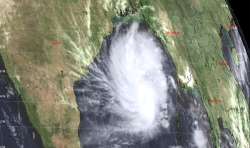Cyclone Bulbul: Over 21 lakh people evacuated in Bangladesh
Bangladesh government has put a temporary ban on movement of ferries and boats in internal river routes alongside all fishing boats and trawlers over the northern part of the Bay of Bengal.

Cyclone Bulbul which was hovering over the Bay of Bengal and India's east coast causing heavy rains in West Bengal and Odisha has hit the neighbouring country of Bangladesh. As per reports, over 21 lakh people have been evacuated in Bangladesh because of cyclone Bulbul.
Bangladesh government has put a temporary ban on movement of ferries and boats in internal river routes alongside all fishing boats and trawlers over the northern part of the Bay of Bengal.
As per reports, a 65-year-old man died after a tree collapsed on his house in southwestern Patuakhali in the wee hours on Sunday as the cyclone battered the coastal district.
In a similar incident, a man died in Khulna as the cyclone damaged hundreds of houses and standing crops on hectares of land.
However, the damages caused by the cyclone were less than what it was feared, officials said.
Bangladesh's Meteorological Department in a special bulletin on Sunday said the cyclone "weakened" and "started crossing" India's West Bengal and Bangladesh's southwestern Khulna coast.
The met office on Saturday issued its highest "great signal numbers" 10 and 9 for the southwestern and southeastern coastlines, prompting authorities to launch a massive evacuation campaign. The met office on Sunday lowered the number to 3.
Disaster ministry secretary Shah Kamal said they initially planned to evacuate 14 lakh people to 5,000 cyclone shelters, however by Saturday midnight, the figure rose to over 21 lakh.
The cyclone was packing winds of up to 120 kilometres (75 miles) per hour and gusts of up to 130 kph (80 mph), while its emergence coincided with the moon phase or full moon, which inflates sea waters, raising fears about the extent of the catastrophe.
However, meteorologists said the damage was less than expected as its landfall came during the low tide early in the morning, instead of midnight when the Bangladesh coasts witness high tide.
"Much of its intensity was lost largely by the time it reached Bangladesh after ravaging West Bengal coastlines," a met office spokesman said.
Bulbul slammed ashore near Sagar Island in West Bengal and approached world’s largest mangrove forest, the Sundarbans, which straddles the Bangladesh-India border.
The government suspended weekend leave for government officials in 13 coastal districts on Saturday. Army troops were also called in to supplement the cyclone preparedness. Boat and ferry movements in internal riverine routes and coastal waters and air traffic operations near coastal airports were completely stopped for nearly 24 hours.
Authorities also suspended all activities in the country's seaports, including in Chattogram Port, which handles almost 80 per cent of Bangladesh's exports and imports.
According to US-based AccuWeather Inc, Bulbul strengthened from a deep depression into a tropical cyclone on Thursday morning, and by Friday afternoon had strengthened into a severe cyclone.
Bulbul was the equivalent of a Category 1 or 2 hurricane in the Atlantic, it said.
Bangladesh's coastal areas are often hit by deadly cyclones, but the country has upgraded its capacity to deal with natural disasters, successfully reducing the number of casualties in recent years.
(With inputs from PTI)
Also Read | Cyclone Bulbul: PM Modi reviews situation, assures all possible assistence to Mamata Banerjee